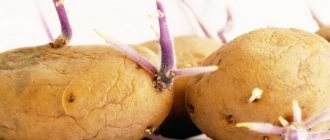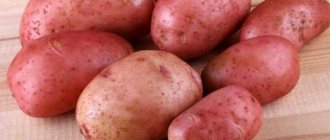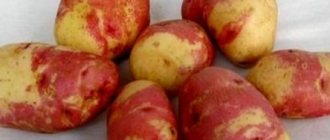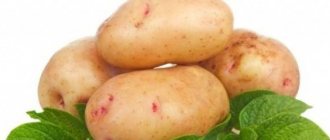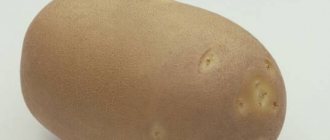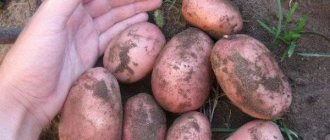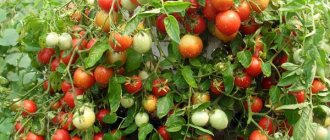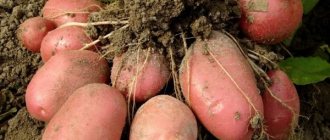The history of the origin of the potato variety "Borovichok"
The variety was bred by folk breeders, but is not included in the state register.
"Borovichok" is well suited for cultivation in warm climates.
In the southern regions of the country (Kuban, Krasnodar Territory, Crimea) 2-3 crops are harvested per year.
The table presents data on the mass of marketable tubers (grams) of different varieties:
| Name | Variety | Weight |
| Nikulinsky | Late ripening | From 70 to 120 |
| Cardinal | Late ripening | 65-110 |
| Rocco | Late ripening | 100-120 |
| Picasso | Late ripening | 80-140 |
| Borovichok | Early ripening | 120-200 |
| Elmundo | Early ripening | 120 |
| Felox | Early ripening | From 100 to 120 |
| Bellarosa | Early ripening | From 120 to 210 |
| Karatop | Extra early | From 58 to 100 |
| Zhukovsky early | Extra early | 100 to 120 |
| Farmer | Extra early | From 90 to 110 |
| Minerva | Extra early | From 120 to 245 |
| Sorcerer | Mid-late | From 75 to 120 |
| Mozart | Mid-late | From 100 to 150 |
| Grenada | Mid-late | From 800 to 100 |
| Melody | Mid-late | From 95 to 180 |
| Giant | Mid-early | 100-140 |
| Tuscany | Mid-early | From 90 to 125 |
| Purple Haze | Mid-early | From 90 to 160 |
| Openwork | Mid-early | 90-120 |
Description of the variety
“Borovichok” is an early ripening variety. Technical maturity occurs 70 days after emergence, full maturity - after 90 days. The average yield is 200-250 centners per hectare of land.
Bushes
The stem is semi-erect, medium leafy. The bush grows up to 50-60 cm and looks compact. The leaves are small, dark green in color, with a slightly wavy edge. The corollas are large, bloom quickly, without setting berries. The root system is medium branched. Up to 10 root crops are formed under each bush.
Tubers
Potatoes are regular oval in shape and small in size. The average weight of one root vegetable is 120-200 grams. The peel is deep yellow, the flesh is creamy. A characteristic feature of “Borovichka” is its smooth and proportionate root crops without signs of lumpyness. The eyes are superficial.
Description and characteristics of the variety
The bush is semi-erect and requires hilling to prevent the stems from falling to the ground. The plant has medium foliage, slightly wavy leaves, reaches a height of 50-60 cm. The flowers are large, snow-white or beige, and produce almost no berries.
Depending on the soil and growing conditions, 9-14 potatoes are obtained per bush. Nest with medium-sized tubers.
Root vegetables have the following characteristics:
- the shape is round or slightly elongated, the surface is smooth and leveled;
- the eyes are small and do not interfere with cleaning;
- the weight of each tuber is 120-200 g;
- the skin is yellow or yellow-brown;
- creamy flesh;
- contains 13-17% starch;
- the harvest during the winter-spring period is preserved by 94%;
- the taste is excellent and rich.
The fruits can be used for baking, boiling, and deep-frying. They have medium friability and universal application.
The plant is endowed with immunity to golden nematode, verticillium, fusarium, cancer, alternaria, and viruses. Resistance to scab and late blight is slightly lower.
History of origin of the variety
The variety is not included in the State Register and has not been tested. It appeared through natural selection in folk selection. This potato is especially suitable for the southern regions, where you can grow 2 or even 3 crops a year, but it is also often cultivated in the middle zone.
In terms of timing, it is classified as early, although ripening within 70-90 days after germination corresponds to a mid-season variety.
Correct fit
To grow strong and healthy bushes, you must adhere to the generally accepted planting stages, the first of which is plantation planning.
Site selection
The landing site must meet the criteria:
- Illumination. The length of daylight for normal potato growing should be at least 12 hours a day;
- Ventilation. The area must be well ventilated on at least three sides, except the north;
- Lack of groundwater. Closely approaching moisture leads to rotting of the plant roots;
- Correct crop rotation. It is not allowed to plant potatoes in the same place for more than 3 years in a row or in a place where eggplants and tomatoes were planted. Good predecessors for potatoes are cucumbers, carrots, beets, and legumes.
Soil preparation
On depleted soils, the decisive factor for high yields is the application of fertilizers during autumn plowing. The most affordable and high-quality option is rotted manure in an amount of 7-10 kg/sq.m. Winter sowing of green manure crops is also widely practiced: alfalfa, oats, rye.
Seed preparation
For planting, root crops are selected from pre-designated powerful bushes and stored separately from the rest of the crop. At the end of March - beginning of April, preparations are carried out before germination:
- Seeds are sorted, leaving only healthy and dense tubers, without damage or bites;
- A month before planting, germination begins. To do this, take the box with seeds into a well-lit room with a temperature of 10-15 * C;
- Before planting, root crops are treated with growth stimulants "Epin", "Zircon" or soaked in a weak solution of potassium permanganate to destroy surface microbes.
Popular potato varieties:
Planting Density
Recommended planting pattern:
- The interval between bushes is 30 cm;
- Row spacing – 60 cm;
- Planting depth – 10 cm.
Boarding time
“Borovichok” is planted in late April – early May, depending on climatic conditions. It is important that the soil is warmed to 10-12*C. In the central regions, planting in a ridge is recommended, as it better protects young shoots from temperature changes.
"Borovichok" does not require special care. Standard agricultural techniques:
- Watering. In dry weather, water once every 3 days, in cool weather - once every 5-7 days. Watering should be root and deep. It should be done early in the morning or late in the evening. The ideal option is to lay a drip system. This type of irrigation not only ensures gradual and balanced soil moisture, but saves liquid consumption by up to 30%;
- Loosening. The main task of the gardener is to prevent the formation of a hard earthen crust that disrupts air exchange in the soil. Therefore, you need to loosen as the soil dries, especially important after watering;
- Weeding. Weeds compete with potatoes for nutrients, attract pests and become carriers of diseases. Therefore, you need to weed the beds regularly, starting from the appearance of the first shoots;
- Feeding. To reap the maximum harvest, in addition to autumn fertilization, two feedings are recommended during the growing season:
- Diluted droppings during the first weeding;
- Superphosphate and mineral complexes during budding.
Care
"Borovichok" does not require special care. Standard agricultural techniques:
- Watering. In dry weather, water once every 3 days, in cool weather - once every 5-7 days. Watering should be root and deep. It should be done early in the morning or late in the evening. The ideal option is to lay a drip system. This type of irrigation not only ensures gradual and balanced soil moisture, but saves liquid consumption by up to 30%;
- Loosening. The main task of the gardener is to prevent the formation of a hard earthen crust that disrupts air exchange in the soil. Therefore, you need to loosen as the soil dries, especially important after watering;
- Weeding. Weeds compete with potatoes for nutrients, attract pests and become carriers of diseases. Therefore, you need to weed the beds regularly, starting from the appearance of the first shoots;
- Feeding. To reap the maximum harvest, in addition to autumn fertilization, two feedings are recommended during the growing season: Diluted manure during the first weeding;
- Superphosphate and mineral complexes during budding.
Reviews about the variety
Gardeners like Borovichok for its ease of cultivation, unpretentiousness to the soil and excellent taste. The yield of the variety is not the highest, but it is stable and does not decrease from year to year. Thanks to the compact root system, digging potatoes is convenient and easy.
Potato Borovichok is an early ripening table variety. From the first shoots to harvesting, it takes from 70 to 90 days. It has good yield; from 1 hectare you can collect more than 200 centners of smooth, beautiful tubers.
Important. Collected root crops are stored well. Despite their thin peel, they are little damaged when digging and can easily withstand manual or mechanical harvesting.
Read all about storing potatoes in winter, in boxes and in the refrigerator, as well as about the terms and conditions for storing peeled root vegetables.
The bushes are medium-sized, compact, erect or semi-erect, with not too spreading branches. The formation of green mass is moderate.
The leaves are medium-sized, dark green, of intermediate type, with slightly wavy edges. The corolla is made up of large white or cream flowers. The flowers quickly fall off and the berries are almost never set.
The root system is well developed; at least 10 large potatoes are formed under the bush. The amount of non-marketable fines decreases when planted in summer, and the spring harvest is more uneven.
In the table below you can see indicators such as yield and number of tubers per bush for other potato varieties:
| Variety name | Productivity (c/ha) | Number of tubers in a bush (pcs) |
| Ilyinsky | 180-350 | 8-13 |
| cornflower | 200-480 | up to 15 |
| Laura | 330-510 | up to 20 |
| Irbitsky | up to 500 | 6-10 |
| Sineglazka | up to 500 | 8-12 |
| Adretta | up to 450 | 15-25 |
| Alvara | 290-440 | 8-14 |
| Breeze | up to 624 | 8-12 |
The variety is little susceptible to diseases: potato canker, various viruses, Alternaria, verticillium, fusarium, golden cyst nematode. It is rarely affected by late blight and scab; in cold rainy weather, root or gray rot may occur.
Plant care is simple. In warm regions, planting begins in March; to protect against cold weather, the beds are covered with film. The next sowing can begin immediately after harvesting the first crop.
In the middle zone, tubers are planted in early May. During the season, plants are hilled 2-3 times; in hot regions, drip watering is recommended. Potatoes can be harvested by machine or by hand.
Yields can be increased by timely application of organic or mineral fertilizers. How and when to apply fertilizers, as well as how to do it correctly when planting, read in separate articles on our website.
Advantages and disadvantages
Pros:
- ease of care;
- great taste;
- the ability to cook in different ways;
- ability to bear fruit on unsuitable soils;
- resistance to a number of diseases;
- good keeping quality during long-term storage;
- high productivity;
- the variety is not prone to degeneration, and can be grown for a long time from its own harvest.
Minuses:
- the skin is too thin and often suffers during transportation and mechanized collection, which reduces commercial quality.
Features of cultivation
In warm regions, potatoes are planted in early spring; in temperate climates, planting is shifted to early May. Agricultural technology is standard. Before sowing, selected tubers are pickled and soaked in a growth stimulator.
Large tubers, cut into segments with eyes, as well as non-marketable small items are suitable for planting. Under favorable conditions, small potatoes give an excellent harvest, the tubers are even and large.
Potatoes prefer fertile, light soils; they grow poorly on loams. The soil can be enriched with humus, peat and wood ash, laid out in the holes.
Tubers are planted with a depth of 10 cm, the distance between the bushes is from 30 to 35 cm. It is advisable to leave wide row spacing for easy plant care. To protect against weeds, the rows are mulched with mowed grass or straw.
During the season, the bushes bury themselves 2-3 times, forming high ridges. In hot climates, it is useful to organize drip irrigation or water the plants by hand 2-3 times per season, soaking the soil to a depth of 40-50 cm.
Root feeding with potassium sulfate, superphosphate, and diluted mullein is useful. A week before harvesting, it is recommended to cut off all the tops, this will allow the tubers to accumulate maximum nutrients.
We also bring to your attention useful information about which sprays and how they will help when growing potatoes.
As well as materials on the use of herbicides and fungicides, their benefits and harm to plants.
There are many ways to grow potatoes. We offer you useful information about Dutch technologies, about growing under straw, in barrels and bags.
Diseases and pests
The potato variety Borovichok is resistant to many dangerous nightshade diseases.
It is rarely affected by potato cancer, golden cyst nematode, and various viruses.
Early ripening saves tubers and leaves from late blight. To prevent plantings, they are treated with copper-containing preparations.
Dosed watering, frequent hilling and adding wood ash to the soil before planting will help protect plantings from rot.
Fresh potato tops attract a variety of pests: Colorado potato beetles, cicadas, spider mites, and aphids.
Treatment with insecticides will help get rid of insects.
To combat the Colorado potato beetle, we recommend using the following chemicals: Aktara, Corado, Regent, Commander, Prestige, Lightning, Tanrek, Apache, Taboo.
Pre-planting treatment of tubers, as well as correct crop rotation, can prevent the appearance of wireworms.
Every few years, potatoes are planted in new areas, and the vacated areas are sown with phacelia or oilseed radish.
The best predecessors for potatoes are legumes, cabbage, meadow or herbs.
Potato Borovichok is a successful variety, ideal for small farms. Yield and tasty potatoes are suitable for sale or personal consumption; you can collect seed material for planting yourself.
“>
There are no similar posts

